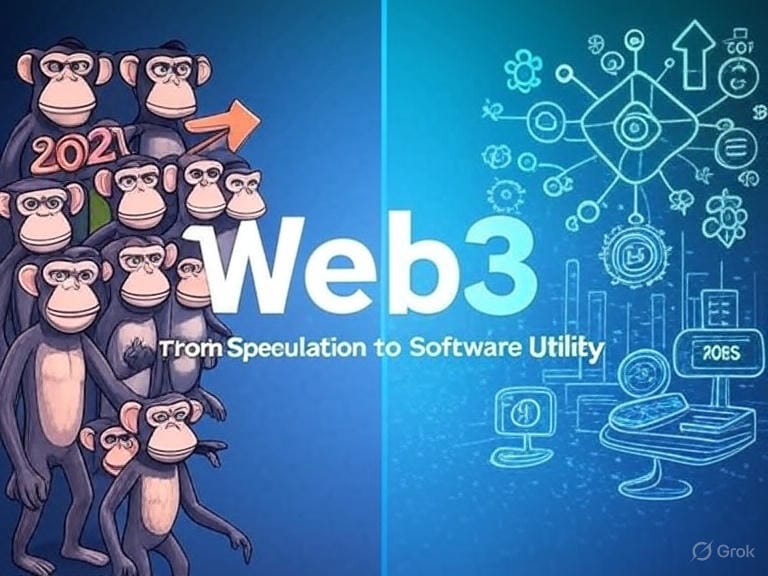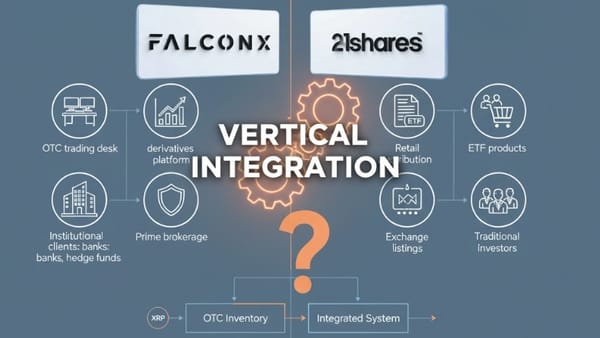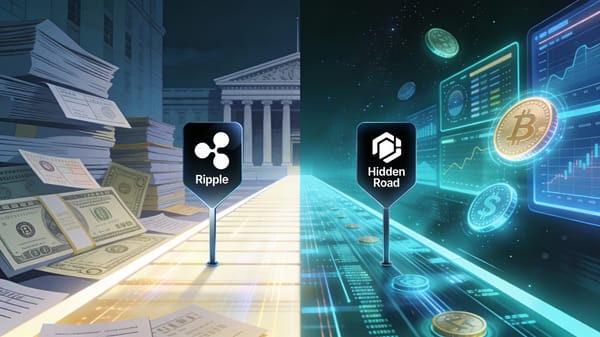Web3 Crypto: The Evolution From Speculation to Software Utility
Web3 crypto has evolved from speculative NFT collectibles to essential software infrastructure. 2025 marks the shift from hype-driven trading to utility tokens powering real-world applications like cross-border payments and decentralized governance systems.

The cryptocurrency landscape has undergone a dramatic transformation. Where 2021's bull run was fueled by NFT collectibles and speculative trading, 2025 marks a new era where crypto tokens "now represent access rights, governance authority, incentivization tools, and real-world assets" rather than mere speculative instruments. This shift from hype-driven collectibles to genuine software utility represents the maturation of Web3 technology.
The Web3 Revolution: Beyond Traditional Crypto
Web3 represents the next evolution of the internet, moving from centralized platforms controlled by tech giants to decentralized applications powered by blockchain technology. Web3 tokens are cryptocurrencies that power decentralized applications (dApps) and services built on blockchain networks. These tokens often provide utility, governance, and access within a Web3 ecosystem, fundamentally different from traditional cryptocurrencies that primarily serve as stores of value.
The distinction is clear: while Bitcoin functions mainly as digital gold and Ethereum as a transaction layer, Web3 tokens enable specific functionalities within their ecosystems. Unlike good ol' Bitcoin or Ethereum, which mainly serve as a store of value or a way to pay for things, utility tokens enable interactions within decentralized applications (dApps).
From NFT Collectibles to Practical Software Tools
The transformation from speculative NFT collectibles to utility-driven applications represents crypto's coming of age. In 2025, NFT utility in presales is no longer a niche experiment. It's becoming the default strategy for community building and early engagement, with projects using NFTs as functional access keys rather than mere profile pictures.
Real-world examples of this shift include:
- Access Tokens: NFTs now serve as membership cards for exclusive platforms and services
- Product Keys: Digital assets that unlock specific software features or beta testing access
- Governance Rights: Tokens that provide voting power in decentralized autonomous organizations (DAOs)
NFTs are moving beyond mere collectibles to serve functional uses, such as gaming, identity verification, and virtual real estate, demonstrating the practical applications that define modern Web3.
Expert Perspectives on the Utility Revolution
Industry leaders emphasize this fundamental shift toward utility over speculation. As noted in recent analysis, "utility has become the buzzword of post-2021 crypto circles. But Pi Network actually lives it", highlighting projects that prioritize real-world functionality over market hype.
The infrastructure focus is particularly notable. Web3 stopped rewarding attention. It started rewarding utility, with successful projects now monetizing through actual usage rather than token appreciation alone.
Tom Taulli, co-author of an upcoming book on agentic AI, explains that regulatory clarity under the new U.S. administration is accelerating this shift: "The new treasury secretary is really deep on crypto, and they're bringing in someone at the Securities and Exchange Commission who is pro crypto", creating conditions for sustainable utility-focused development.
Understanding Web3 Investment Metrics
Traditional cryptocurrency valuation relied heavily on market capitalization and speculative potential. Web3 utility tokens require different analytical frameworks that focus on actual usage and network value.
Key Web3 valuation metrics include:
- Daily Active Users (DAU): Daily Active Addresses (DAA), also known as Daily Active Users, measure how many users transact daily on a blockchain network
- Total Value Locked (TVL): TVL indicates the crypto assets' value deposited in a DeFi protocol. A direct indicator of the trust and confidence users have in your protocol
- Network Utility: Real-world use cases and integration with existing systems
- Token Velocity: How frequently tokens are used within their ecosystems
Crypto markets do indeed contain inefficiencies that can be exploited by a value-oriented approach, but the focus has shifted from purely financial metrics to measuring actual technological adoption and user engagement.
XRP/Ripple: A Case Study in Web3 Utility Evolution
Ripple's XRP exemplifies the transition from speculative asset to enterprise utility token. Rather than fading, XRP has shifted from retail speculation to enterprise utility, establishing itself as infrastructure for cross-border payments.
XRP's Web3 transformation includes:
- Cross-Border Settlements: XRP supports real-time settlement, cross-border remittances, and tokenized financial instruments
- Enterprise Integration: Partnerships with financial institutions for practical payment solutions
- Regulatory Compliance: Working within existing financial frameworks rather than disrupting them
- RLUSD Stablecoin: Ripple's RLUSD stablecoin received regulatory approval in Dubai, enhancing XRP's appeal as a cross-border payment solution
Current price predictions reflect this utility focus, with analysis estimates that the XRP price could hit $3.06 by the end of 2025 based on institutional adoption rather than speculative trading.
The broader investment thesis recognizes XRP's unique position: XRP is used mainly by banks and other financial institutions looking to faster, less expensive ways of bridging fiat currencies, differentiating it from purely speculative cryptocurrencies.
The Future of Web3 Utility
The infrastructure buildout continues accelerating, with experts believe altseason will not only be a price race, but a season marked by the tangible utility of Web3 and active user participation in the crypto ecosystem. This represents a fundamental shift from previous bull cycles driven by speculation.
Projects succeeding in 2025 focus on solving real problems rather than creating market hype. Great utility is when using the product requires and benefits from using the token, establishing sustainable demand based on actual functionality rather than speculative value.
The development ecosystem reflects this maturity, with token development services offer end-to-end support, including use-case definition and token classification (utility, security, governance, or RWA-backed), professionalizing the space beyond quick money grabs.
Software Utility Over Speculation
Bottom Line Up Front: Web3 crypto has evolved from speculative collectibles to essential software infrastructure, with utility tokens now powering real-world applications from cross-border payments to decentralized governance systems.
The transformation is complete: successful crypto projects in 2025 derive value from actual usage rather than market speculation. Whether enabling instant international transfers like XRP or powering decentralized applications through utility tokens, the focus has shifted decisively toward solving real-world problems.
For investors, this means evaluating projects based on technological merit, user adoption, and practical applications rather than hype cycles. The Web3 revolution isn't about replacing traditional finance overnight—it's about building sustainable digital infrastructure that creates genuine value for users and enterprises alike.
Understanding these new investment metrics and utility frameworks positions investors to identify the next generation of successful Web3 projects, where software functionality drives long-term value creation.
DISCLAIMER: This newsletter is for informational purposes only and does not constitute investment advice or a recommendation to buy, sell, or hold any securities. Investments in cryptocurrencies or other financial assets carry significant risks, including the potential for total loss, extreme volatility, and regulatory uncertainty. Past performance is not indicative of future results. Always consult a qualified financial professional and conduct thorough research before making any investment decisions.



